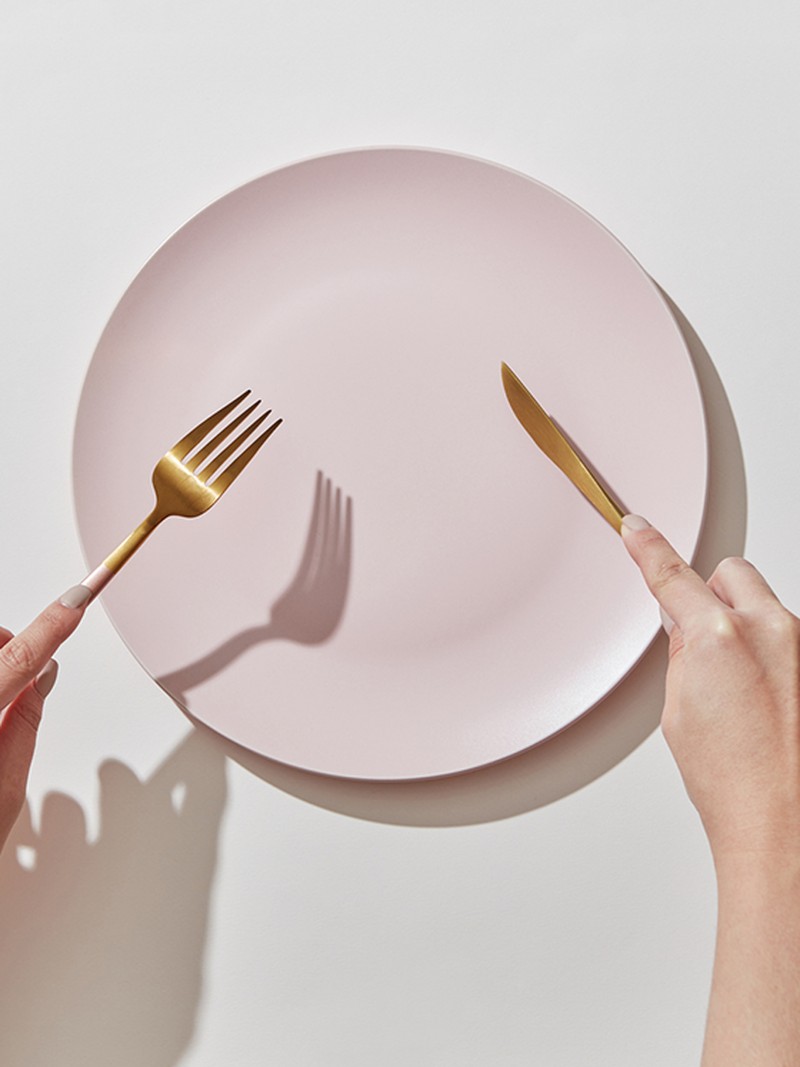A Nutritionist’s Guide To Fasting & How To Do It Right
DO
Reframe How You See Fasting
“If you’ve tried fasting before – either in the form of the 5:2 or a prolonged overnight fast – and gave up because you were hungry all the time, you weren’t doing it right. Fasting isn’t about being hungry. It’s about making your body and metabolism more flexible. When we eat, sugar is released into the blood, which is then used as energy, with any excess stored in the liver or muscles. If these stores are full, then glucose is converted to fat. If we take away this influx of glucose by not eating for a period, our body will turn to those energy stores to meet its demands. For most of us, this process kicks in after 12-16 hours of fasting. At this point, you’ll start to see the benefits for your health, including fat loss, mental clarity, reduced inflammation and better immunity. Fasting will also make the fat you do have more metabolically beneficial. Remember, as women, we need some fat.”
Understand The Benefits
“When you fast, you teach your body to use ketones – i.e. stored fat – instead of glucose as its primary fuel source. This is at the crux of fasting and will improve blood glucose control and cardiovascular health and reduce blood pressure. If your body is switching between glucose and ketones, it also means you’re using stored fat as fuel, which will lead to fat loss. If paired with strength training, you’ll remodel the body and supercharge your muscle to fat ratio. The benefits for cognitive function are also undeniable. The brain is an energy intense organ and wants 50:50 glucose and ketones. Fasting will get rid of brain fog, mood instability and memory concerns. For those with addictive behaviours, depression and low mood, fasting can reset the brain and significantly reduce symptoms.”
Think About Your Hormones
“Throughout our cycle, our levels of oestrogen and progesterone rise and fall. Both hormones create very different situations when it comes to how our body reacts to food. In the first half of the menstrual cycle, oestrogen is our dominant hormone, and then from ovulation to the few days before our period, progesterone is dominant. Immediately before our period, both hormones decrease. When oestrogen is at its peak, we are more metabolically flexible. Our energy levels are higher, we need fewer calories, and we thrive on more protein and fat – which makes intermittent fasting at this stage of the cycle easier. When we move past ovulation, however, energy drops and insulin sensitivity changes, creating an increased likelihood for sweet cravings and snacking if meals aren’t well balanced. Fasting isn’t out of bounds in the latter half of the cycle, but you’ll need to relax the boundaries. Aim for a 12-14 hour fast between dinner and breakfast rather than 14-16, and accept that it may take four or five cycles to get into the swing.”
Stay Hydrated
“Fasting will increase your need for water and electrolytes. Aim to have at least 500ml of water and a pure, unflavoured electrolyte complex (I rate Elete hydration) before eating and then consistently sip over the day.”


DON’T
Count Calories
“It may sound ironic, but fasting isn’t about creating a calorie deficit. It’s about retraining your body to use fuel from the food you eat differently. One of the most common mistakes I see women making when it comes to fasting is under-fuelling the body and asking too much of it. We’ve long been taught that we need to eat less and move more, but the body doesn’t work in this way – if you undereat for an extended period of time, the body protects itself and clings onto fat as a protective strategy. Yo yo-style caloric restriction will always lead to bounce-back weight gain – studies show you’ll see an average 10% increase on your starting weight.”
Underestimate The Role Of Stress
“If your diet is balanced, you’re getting quality sleep every night and you’re keeping stress under control, you’ll reap the benefits of fasting – it’s all about the bigger picture. However, if you’re over-exercising and under-resting while following a poorly managed fasting schedule, you’ll likely end up exhausted and hungry with low mood, an irregular menstrual cycle and an increase in body fat, especially around the centre of the body. You’ll also compromise your immune system and find yourself coming down with every cold and sniffle doing the rounds.”
Exercise On An Empty Stomach
“Intense HIIT workouts on an empty stomach are never a good idea for women – it wreaks havoc with our hormones. Stress hormones and insulin rise, which prevents fat metabolism, thus causing fatigue, muscle injury and low mood. It’ll also negatively impact your reproductive hormones. If you love to exercise in the morning, opt for strength or resistance training with short bursts of cardio in your follicular (oestrogen dominant) phase, having had a heaped teaspoon of nut butter beforehand. This will give you fuel while keeping you in a fasted state. Swap to walking, Pilates or yoga in your luteal phase.”
Fast If You’re Pregnant Or Breastfeeding
“Done properly, the benefits of fasting are endless. However, it should be avoided by those with a history of an eating disorder; pregnant or breastfeeding women; those with menstrual irregularities unless under the care of a specialist; those with low blood pressure; or type 1 diabetics.”
Rush Into It
“Start by making your breakfast 30-60 minutes later and dinner 30-60 minutes earlier – this is key to phasing into fasting slowly. Also focus on having gaps between meals: can you go three-and-a-half or four hours between meals without feeling hungry? If not, you’re not eating balanced meals and your blood sugar is fluctuating. Focus on this first: ensure there’s 35g of protein in every meal, as well as two fist-sized portions of fibrous veg and one to two tablespoons of fat. Start by only trying an overnight fast in the follicular phase of your cycle; avoid stimulants or intense exercise in a fasted state; and prioritise sleep and recovery.”
KEEN TO GIVE IT A GO?
Here, Phoebe shares her ideal day of fasting…
“Try this for a week. What you’ll quickly see is how your hunger signals change. You’ll soon realise you can go without snacks and, without even realising it, you’ll go from 7pm to 9am quite easily without eating. This eating structure is safe for everyone.”
Morning
Drink 500ml of water on waking with some electrolyte drops and spending five to ten minutes in bright, natural daylight as soon as you can.
If you feel hungry, have a ‘fasting snack’ – a teaspoon of walnut or pecan butter, or a black coffee or tea with one tablespoon of MCT oil. The nut butter is preferable – if you can start the day without an immediate burst of caffeine, even better.
With or without this snack, go about your morning, and if you feel like exercising, keep it gentle – walking, cycling to work, Pilates and yoga are good options that will encourage your body to start using circulating energy.
Break your fast around 14 hours after dinner with a protein and fibre-rich breakfast.
Throughout The Day
Aim to leave a four-hour gap between periods of eating to allow insulin levels to drop and the digestive system to complete its processes.
If hunger creeps in before this, have a teaspoon of nut butter or a cup of bone broth with a teaspoon of ghee or MCT oil. It’s not about denying hunger, it’s about interacting with hunger in a different way.
Evening
Aim to finish dinner three hours before going to bed with a ten-to-15-minute gentle walk after your meal.
Be in bed at a time that gives you the opportunity to have at least seven hours of sleep – this has a direct impact on metabolism.
General Rules
Start all meals with one teaspoon of raw apple cider vinegar in 200ml of water and a handful of vegetables – this could be a carrot or some celery sticks.
At every meal, include at least 30g of protein. This could be 110g of chicken, 100g of steak, or two eggs and half a cup of cottage cheese. Also include one to two tablespoons of good-quality fat with each meal. Some fat may come from your protein (oily fish, for example, contains both protein and fat) but add olive oil, avocado, nuts seeds, or organic dairy and coconut products to bring to two tablespoons worth of fat in total.
Finish your meal with a cupped handful of slow-burning carbs – think wholegrain rice, pearl barley, beans, pulses, legumes and root vegetables cooked with their skins.
For more from Phoebe, visit NaturalNourishment.me & follow her on Instagram @_NaturalNourishment.
DISCLAIMER: Features published by SheerLuxe are not intended to treat, diagnose, cure or prevent any disease. Always seek the advice of your GP or another qualified healthcare provider for any questions you have regarding a medical condition, and before undertaking any diet, exercise or other health-related programme.
DISCLAIMER: We endeavour to always credit the correct original source of every image we use. If you think a credit may be incorrect, please contact us at info@sheerluxe.com.


